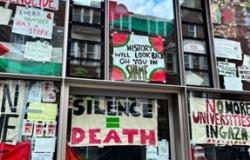A Theory of Decolonial Imaginations

This is the second chapter in a forthcoming e-book, entitled 'Decolonial Education and Youth Aspirations', edited by Nyashadzashe Mandivenga and Sara Camacho Felix.
In October 2015, university students in South Africa began a massive movement, starting at Witwatersrand and then expanding across the country, demanding that #FeesMustFall. They urged universities to find alternative ways of operating outside of the fees system and linked this demand to a need for universities to decolonise, seeing the connections between the fees system and colonial administration (Langa et al, 2017). In 2019, students in Iraq took to the streets, leading the movement against corruption and the rule of oligarchs, resulting from the USA invasion and occupation. Their chants, among many, included ‘we want a homeland’, recognising the role of foreign interest and capitalism in dismantling their futures (Ibrahim, 2019). That same year, in Chile, protests led by university students also took place, with one of the main grievances being youth unemployment and massive inequalities (Cuffe, 2019). In 2020, in the height of the pandemic, police in the USA murdered George Floyd, and with that came the resurgence of the #BlackLivesMatter movement in the USA, demanding that Black bodies be deemed human, worthy of life (Silverstein, 2021). This sparked protests in the UK, where protesters threw a statue of Edward Colston into Bristol harbour. This was a statue honouring a slave trader made rich from selling Black bodies in the sugar trade (Siddique & Skopeliti, 2020). And in 2024, students across the world took to tents and university occupations, as they demanded an end to complicity in the genocide of Palestinians at the hands of the Israel’s settle colonial government (Ibsais, 2024).
These are some of many moments when I have learned lessons from students. These have been moments when they have taught me what it means to demand a different life and something better than what is currently offered by the colonial capitalist system under which we live. As an educator in universities in the UK, it is these moments outside the classroom that I have found most hopeful and aspirational, where I have felt that something other than coloniality and capitalism is possible. These moments have inspired changes in my curricula and in my pedagogies. My imagination of futures otherwise has been directly informed from actions outside the classroom rather than from anything I have done in the classroom. I have seen Freire’s Pedagogy of Hope (1992/2021) and hooks’s Teaching Community (2003) enacted in spaces such as the encampments of 2024, and it is those moments that challenge me to rethink my own work as an educator. Slowly, I have found myself moving away from the ‘sociology of doom’ (Ajai-Thomas, 2021) so commonly infecting the work of academics like me that study inequalities (in my case, the inequalities of higher education linked to coloniality and neo-imperialism) and moving toward a pedagogy focused on decolonial imagination.
However, much of this pedagogic work I have done has been an embodied, almost instinctive, move, where I have attempted to change pedagogically as I’ve witnessed, and this witnessing has sparked imaginings otherwise. Theory has been there. Always. As bell hooks writes ‘I found a place of sanctuary in "theorizing," in making sense out of what was happening. I found a place where I could imagine possible futures, a place where life could be lived differently’ (hooks, 1991, p.2). So, this chapter is my attempt to put the theoretical words to what I see as the power of decoloniality to spark the imagination, which is so central in breaking the dominance of coloniality as a world-system.
Therefore, in this chapter, I lay out the possibilities of a decolonial imagination as central to any pedagogy for a future no longer affected by existential crisis, away from genocidal, capitalist coloniality, and into a world built on mutual aid. It is an attempt to put into words the theorising that has been happening in my mind as I have engaged with imaginations in my own teaching practice. I begin by defining coloniality, focusing on how the coloniality of the body and of knowledge interlink to justify capitalism and colonialism, and in doing so, limit imagination. From there, I consider pluriversality and mutual aid as antidotes to this limited imagination, offering the stepping stones for a decolonial imagination. Finally, I conclude with some reflections on what this might mean in universities that forever influence and shape youth aspirations.
Coloniality as limiting the imagination
As other chapters in this collection do, I feel the need to start with breaking down coloniality to explore what coloniality and its current iteration does to the imagination. This world system (Cox, 1964; Amin, 1991), whether called racial capitalism (Robinson, 1983/2021) or coloniality (Quijano, 2000; 2007), is one that not only impacts political and economic systems, but also co-opts our thoughts and our imagination. In this section, I break that down to understand the links between coloniality and the limited imagination.
Let me start by stating clearly – colonialism was both a racist project and a capitalist project. As Robinson (1983/2021) details, the racism of Europe (and her settler colonies) was infused into the capitalist system to justify the inequalities needed for capitalism to function. Under colonialism, bodies were deemed non-human, and exploitable for labour or deemed wasteful and therefore to face genocide. This link is important to understand what is coloniality.
Coloniality is not just about the colonial period, where Europeans maintained direct political power over large swaths of the world. Rather, coloniality is the ‘long-standing patterns of power that emerge as a result of colonialism, but that defined culture, labour, intersubjective relations, and knowledge production well beyond the strict limits of colonial administration’ (Maldonado-Torres, 2007, p. 243). In other words, coloniality and its matrix of power (Quijano, 2007) continue to inform the modern world long after the supposed end of direct colonial rule. As Ndlovu so aptly puts it, ‘the collapse of colonialism was simply a performative episode within a prescriptive continuous historical structure of coloniality’ (2018, p. 97). The end of colonialism did not end coloniality; rather it took on a new shape that allowed the colonial matrix of power to continue. It is a matrix of power that informs our economic systems (capitalism), our knowledge production, our cultural norms, and, as I argue here, our imaginations.
Central to coloniality is the hierarchy of bodies, where whiteness represents the most human (Quijano, 2000), creating a global colour line (Dubois, 1903/2008) where those above it are seen as human and whose way of understanding the world is recognized knowledge. Linked to whiteness (or Europeanness) is the hierarchies of knowledge that place knowledge derived from Europe and her settler colonies – including modernity and the logic of global capitalism – as superior to knowledges that are embodied by those outside of whiteness. This web connecting bodies and knowledge offers an unfulfillable promise that by internalising the knowledge of Europe and her settler colonies, one might be granted proximity to whiteness to therefore be seen as more human. The ontological (bodies) and the epistemological (knowledge) are forever linked. This knowledge that might offer proximity to whiteness is clear – it is a knowledge that not only centres Europe and her settler colonies (Quijano, 2007), but a knowledge that justifies capitalism. This also means that even within Europe, knowledges that counter capitalism are discredited and rendered invisible.
Therefore, the only way to act logically is through the limited knowledges that justify by coloniality and capitalism, specifically racial capitalism (as Gilmore (2020) states, ‘all capitalism is racial capitalism’), and that all solutions beyond that are ‘irrational’ as they deviate from the logic of coloniality. Throughout the long durée of history, this dominant logic was used to justify the expropriation of land from the original custodians, using genocidal means when necessary (Quijano, 2007). This logic was used to justify who gets to move where (coloniality of migration) in terms of useful bodies where borders delineate labour based on colour of skin and place of origin (Astolfo & Allsopp, 2023). This is a process used during the transatlantic slave trade (Robinson, 1983/2021) and still used today in, for example, the migration of care workers (Bhattacharya & Denvir, 2019).
Coloniality has limited the imagination in such a way that only capitalism and Euro-centric knowledge offers the answers to problems that society faces today. We see coloniality in how capitalism, through green technology and growth, is framed as the solution to the climate crisis even as it is capitalist logic that caused the problem to begin with (Rajkovic, 2020). Neoliberalism, as the latest form of capitalism, sees solutions only through the lens of competition and creating markets, be it between states, institutions (such as universities), or individuals. Coloniality and capitalism informed Margaret Thatcher’s claim that ‘there is no alternative’ as capitalist austerity was offered as the answer to capitalist recession, along with her proclaiming that ‘there is no society’. Nothing exists and therefore nothing can be imagined beyond the capitalist exploitation of bodies, justified under racist logics as part of the coloniality of knowledge and bodies.
This, as Quijano states so clearly, is the ‘colonisation of the imagination’ (2007, p. 169).
The pluriverse, mutual aid, and the imagination
While decoloniality, as a world system that is free from coloniality, offers many ways of imagining how the world might be constituted, in this chapter I want to focus on two specific elements that I feel are necessary to liberate the imagination from the boundaries of capitalist coloniality. The first is the ‘pluriverse’ and the second is ‘mutual aid’.
The pluriverse is the antithesis of the universal that comes from Euro-centric colonial thought which centres European thought and universalizes it to understand the world while also provincializing all other knowledges and denying their utility to theorise the world. In doing so, Euro-centric universalism becomes a means of justifying the hierarchies of knowledge (and through that, of bodies) that are the backbone of the current world system. Without ever using the term ‘pluriverse’, Aimé Césaire offers this description of a ‘new universal’ that sits within the frame of the ‘pluriverse’: ‘I have a different idea of a universal. It is of a universal rich with all that is particular, rich with all the particulars there are, the deepening of each particular, the coexistence of them all’ (Césaire, 1955/2001, p. 25). Meanwhile, the Zapatists define the term as, ‘a world where many worlds fit’ (Ejército Zapatista de Liberación Nacional, 2007). In other words, the pluriverse is a way of recognizing that all knowledges that are locally and contextually bound can be used to understand the global, the world. All knowledge can be used to understand how the world works even as it is bound up in the geographies of those bodies that created the knowledge. Indigenous knowledges, be they from Nigeria, Canada, Palestine, or anywhere else, have the power to be used to understand the world. And in doing so, it creates a ‘universal rich with all that is particular’ or ‘a world where many worlds fit’.
This pluriverse begins to liberate the imagination from the single theoretical frame that has been key to maintaining a capitalist colonial order long after the physical act of decolonisation. It gives permission to the student, the teacher, the thinker, or whomever else to imagine a future world that draws on other particulars and what they might look like when made global. It allows the realm of possibility to open up beyond what has come from capitalist Europe. And with that opening up comes new ideas for the future, how it might be constituted and the role of generations to come to build these futures. Suddenly, Margaret Thatcher’s edict, echoed by so many other world leaders (including David Cameron and Angela Merkel), seems small, limited, and no longer valid. There are alternatives.
The second concept is mutual aid, a term that has often been robbed of its radical anti-capitalist roots when it is used uncritically in NGO discourses. Therefore, I want to begin with Pyotr Kropotkin and his definition of the term. He argues that it is through cooperation (or mutual aid) that societies progress. By working together as collectives for the betterment of all, quality of life is raised for all. He looks not only at the histories of societies that operate from mutual aid to demonstrate this, but even in nature, how it is through herds and flocks that species survive, not through competition within the species (Kropotkin, 1902/2009). Kropotkin focuses on mutual aid as the antithesis of Social Darwinism’s concept of ‘competition’ as being central to how humans, as a species, improves through the idea of ‘survival of the fittest’. This erroneous application of Darwinism (Badertscher, 2020) is still implicitly used to justify the capitalist world system - that competition offers better solutions than collective knowledge. Kropotkin’s focus on mutual aid offers a theory of the world otherwise, that though originating from Europe, has been rendered invisible. This is because it stands against the logics of competition and individualism that allow capitalism and coloniality to endure. In other words, his work was a direct political act against capitalism from within Europe.
While Kropotkin’s concept of mutual aid offers us an understanding of solidarity born out of European thought, there are other particulars that offer divergent theories to understanding this concept of cooperation that both pre- and post-date Kropotkin’s own work (and that undoubtedly influenced him as he himself referred to society and communities beyond Europe). This includes the often-cited concept of ubuntu as a notion of relationality and interconnectedness with others (Molefe, 2019), as well as the Zapotec concept of guelaguetza that is the idea that ‘we encounter one another in sharing’ (Guerrero Osorio, 2019, p. 131). Each of these is different, offering nuanced particulars in how they understand human togetherness or solidarity. But in doing so, they each offer ways of theorising how togetherness or solidarity or mutual aid is necessary for a better future.
This idea of mutual aid shifts how imaginations happen in a way that is radically different from capitalist coloniality. The capitalist imagination fuels individual innovation, which is to be sold on the market, deemed valuable only in how it competes with other ideas. However, the decolonial imagination is no longer about individual success, but rather about communities, peoples, and solidarities. What could the future look like if it were built based on a system of mutual aid rather than a system of capitalist competition? What we are imagining is different, and through the pluriverse, this is ‘what’ is opened up. The answer to present ills is a future that goes beyond the limits of the colonial imagination, that sees community and solidarity as central to that alternative future.
However, mutual aid also shifts how imaginings happen. They do not only happen within individual minds, but they happen together, as communities, in relationality to and with each other. It is not solely one person’s imagination that comes from a single mind, but a collective imagination that we develop in relationality with others with whom we act in solidarity. The imagination is broken free from the individual to be something that we do together, through our differences (Lorde, 1984), recognising the particularities of different worlds while we imagine. The decolonial imagination, set free from the ‘colonisation of the imagination’, is one that imagines together in community for a future that is built together.
Implications for universities and youth aspirations
Now having a theory of a decolonial imagination, I sit wondering what this means for universities, who ‘educate’ future generations of leaders and shape youth aspirations. Much of this decolonial imagination is happening in practice across the movements that I cite at the start of this chapter; however, I am not sure how much is happening in classrooms within universities, especially in the United Kingdom.
Through capitalist discourses of framing universities as building students’ employability (Camacho Felix, 2016; Noonan & Coral, 2015), the aspirations that universities foster are increasingly limited to individual economic dreams. Not only this, but when students do develop spaces of communal imagination demanding alternative futures on campus, as is the case with the student encampments for Palestine, university administrations actively seek to stop them, including taking legal action (Parke, 2024). This highlights the level of coloniality that shapes how universities operate, both within and beyond the classrooms. We are actively limiting what can be aspired to by enforcing, consciously or not, a colonial imagination. Youth can have aspirations, but only those that fit within the current world system.
Therefore, to break this and see the possibilities of decolonising universities, means breaking free from the limitations we, within universities, impose on ourselves and our students. It means bringing those spaces outside of the classroom not only onto campus, but into the spaces where education is alleged to happen. Youth are telling us their aspirations – universities now need to reconstruct themselves (ourselves) to address and build those aspirations. It means classrooms that operate as a community, where learning, ideas, and theories are engaged through dialogue rather than in competition with each other. This changes not just classroom interactions to aim for a more dialogic education as advocated for by hooks (1994) and Freire (1970/1996), but all notions of education. Discussion versus dialogue (Allman, 2010) needs to be questioned. The entire relationship between student and teacher needs to be scrapped. The physical shape of classrooms needs to change, and the concept of assessment needs to be reimagined (or thrown out) as the very concept of an ‘argument’ that aims to convince often limits dialogue and mutual aid. And what is imagined needs to come from spaces otherwise – the spaces where other thinking is happening.
This feels utopian to write, and in my head, I hear the neoliberal critique of how it is naïve and not possible. I hear Thatcher reborn in my own world of self-doubt because of how my mind has been colonised (wa Thiong’o, 1986). I know that students will need jobs to survive because the world that currently exists is one where youth must live. Food, shelter, and life is all dictated by capitalism and coloniality. However, until we start allowing an alternative imagination to form, this current world system will remain a limiting factor on what can be done to build better futures. Universities, to be relevant and to speak to aspirations that youth hold for a better world, have to embrace this different way to imagine the world. We must rebuild these universities to operate in radically new ways. Youth are already doing this without universities (or maybe even despite universities). The question then lies – are we to build these aspirations with youth, or to stand as roadblocks in a system that continually fails to offer a better world?
Sara Camacho Felix is a Senior Lecturer of Global Cultures and Liberal Arts Education in the Department of Interdisciplinary Humanities at King’s College, London.
Bluesky: https://bsky.app/profile/sarafelix.bsky.social
LinkedIn: https://www.linkedin.com/in/smcf2008/
Image: Sara Camacho Felix, Marshall Building at London School of Economics, taken on 6 June 2024


